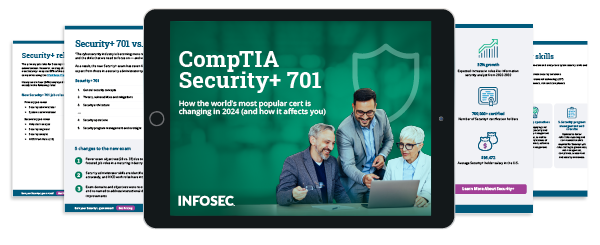Navigating Security+ performance-based questions
The CompTIA Security+ certification is internationally trusted to certify foundational, vendor-neutral IT security knowledge and skills meeting DoD 8570 compliance. There are over 700,000 Security+ certification holders, making it the most popular entry-level cybersecurity certification available.
This certification ensures you have the complete knowledge and expertise to handle and manage security functions. The Security + exam emphasizes hands-on troubleshooting skills that prove you can secure systems, software and hardware.
To that end, they’re continuously updating their performance-based questions (PBQs), which test a candidate’s ability to solve problems in a simulated, virtual environment (e.g., a firewall, network diagram, terminal window or operating system) — see the CompTIA Sample PBQ Answer Key The Security+ exam is comprised of both PBQs and multiple-choice-questions (MCQs).
For more information on the Security+ exam, get your free Security+ ebook and webinar.

Understanding performance-based questions
A performance-based question involves performing a task or solving a problem. The exam now places increasing importance on these types of Q&As to assess the practical understanding of the candidate.
The rationale behind PBQs is they give you a chance to demonstrate problem-solving skills in the context of real-world scenarios. For instance, you might be asked to provide details for an access control list on a router or firewall. For example, if you must allow a specific IP address through, you might add an exception in the ACL to allow traffic from or to this IP address.
In this way, PBQs test your ability to make a sound decision, replicating what should be done in a real-life situation.
Structure and types of performance-based questions
There are three primary types of performance-based questions:
- Scenario-based questions. These present a hypothetical scenario such as a malware infection or breach. This way, it evaluates your ability to apply your knowledge to mitigate security risks.
- Simulation questions. These questions simulate real-world cybersecurity tools like firewalls or intrusion detection systems. You’re then asked a question in the context of the tool you’ve been presented. For instance, you may be asked how to configure a firewall to prevent specific attacks.
- Drag-and-drop questions. With drag-and-drop questions, you have to move elements around to demonstrate that you know how they relate to each other. For instance, you may be asked to drag and drop the steps needed to formulate an incident response plan, putting them in the correct order from first to last.
Become a SOC Analyst: get Security+ certified!
More than 47,000 new SOC analysts will be needed by 2030. Get your CompTIA Security+ to leap into this rapidly growing field — backed with an Exam Pass Guarantee.
Preparing for performance-based questions
Preparing for performance-based questions involves understanding the exam’s objectives, practicing in real-world scenarios and honing in on areas where you may struggle.
When practicing in real-world situations, you should:
- Use virtual labs or simulation software that imitates the cybersecurity tasks you may be asked to perform on the exam.
- Practice responding to incidents, identifying vulnerabilities, and configuring security systems according to best practices.
- Try to use a variety of different scenarios. For instance, you may want to focus on incident response during one session, tool configuration in another session, network design in another, and security in cloud computing in another.
One way to prepare for PBQs is to use the Security+ PBQ examples on CompTIA’s website. These have the same format as the ones you’d face on the exam and cover the same topics you’ll encounter.
Time management should be a primary concern, especially because PBQs can quickly consume much of your time on the exam. Some people report not having enough time left over for other exam questions because PBQs take so long to do. To avoid this predicament, it’s best to skip a PBQ and return to it later if it seems like it will take a while. That way, you still get to answer other questions, which could boost your overall score.
Tips for passing your Security+ exam
The PBQs are essential to the exam, but don't overlook the basics, warns Infosec Security+ instructor Tommy Gober.
"Learn the terminology, says Gober. "That's probably the biggest stumbling block. I think that anybody who has taken the exam will agree that there is so much vocabulary in there."
On the first day of his Security+ Boot Camps, Gober tells his students to download the official exam objectives (view pdf) to track their progress.
"Keep a copy on hand and then go through with a pen, check off things as you understand them. If you can describe what this bullet point is about to your cat or your neighbor's fence post, put a line through it. Then, if you don't understand it, skip it and move on. Do a real, honest, personal assessment of the content. Then, once everything's checked off, guess what? You're ready to go."
Some test takers in online forums report that the PBQs feel foreign and are more complex than the other types of questions. Being confident in all the terminology can help. It may also be helpful to try several different practice PBQs using a combination of online resources and an exam prep boot camp.
By getting broad exposure to a range of questions, you decrease the chances of encountering one that feels unfamiliar on the exam.
Be ready for the SY0-701 exam
All the information you need to make sure you're ready to ace your Security+ exam in one free ebook.
The relevance of PBQs to cybersecurity careers
The skills tested in PBQs translate well to real-world cybersecurity tasks and responsibilities because they mimic realistic scenarios. For example, you may face a PBQ that requires you to check the configuration of a router to figure out why specific computers don’t have access to the internet.
To do this, you have to know which configurations the router should have, what they look like, and the effect they have on the network access of endpoints. This is precisely what you’d need to know in a real-life situation.
Some PBQs may test higher-level knowledge, such as structuring mitigation procedures. These also benefit you in an on-the-job scenario because they enable you to leverage the functionalities of security tools and the effectiveness of different methods. This knowledge is also directly applicable as you work professionally with team members.
This way, test prep materials for PBQs give you hands-on experience that translates well in a real-world context.
Navigating the CompTIA Security+ exam
The CompTIA Security+ exam consists of a maximum of 90 questions. These consist of a combination of PBQs and multiple choice.
To pass the exam, you have to score 750 on a scale of 100 to 900.
You can check out our Security+ Exam Overview article for a more detailed overview. This details what the exam covers, its different domains, how much it costs to take, preparation tips and more.
The registration process is relatively straightforward. You go to CompTIA’s site, create an account if you don’t already have one and then use the link on the page to schedule your exam. You’ll then get an email confirming the details of your exam. You must bring this to the test center when you sit for the exam.
Beyond the exam: career path and opportunities
Earning your CompTIA Security+ certification paves the way for diverse For instance; you can become a security administrator, specialist or engineer. You can also become a network admin, penetration tester or consultant.
Of course, the certification can prepare you for other job titles, including those that may be tangential to cybersecurity, such as those involving network architecture and engineering.
The CompTIA Security+ certification will help you break into the industry, but it will only be the first step for most. This certification will get you in the door at companies, but higher-paying jobs will only be available as you add to your resume.
Be ready for the SY0-701 exam
All the information you need to make sure you're ready to ace your Security+ exam in one free ebook.
Leverage PBQs to elevate your cybersecurity career
Performance-based questions give you a chance to flex your knowledge in life-like scenarios. They also allow you to demonstrate your understanding of how different cybersecurity tools and procedures work together. This makes them valuable to the certification exam because they bridge the gap between knowledge and practical application.
Using the information, tips and resources above, you’re ready to tackle the PBQs. Embrace the challenge and have fun with it because these questions can be a springboard to a lucrative, rewarding career in cybersecurity.
To dig deeper, check out our Security+ ebook and Security+ hub for more information.




